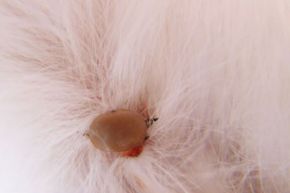Fleas are one thing, but if you're petting your cat and come across a tick, well, it's a whole different ball game -- that thing is attached! Ticks are small, blood-sucking insects that bury their mouth parts in the skin of warm-blooded animals. Once a tick begins to feed, its body expands. A gorged tick may look like a small mole or a roundish bump of odd-colored flesh. They're usually found on bushes or low trees, and drop onto passing animals -- like your cat.
Ticks aren't just disgusting, they're potentially dangerous. Because their mouths make contact with the bloodstream of their hosts, ticks can transmit serious diseases, including Lyme disease and similar illnesses. That's why they have to be removed as soon as possible -- and with their entire body intact. The longer the tick is embedded, the greater the risk of spreading disease. It's vital that the whole tick is removed because any part left behind could still contain infectious matter.
Advertisement
If you find a tick on your cat's body, remove it immediately (while wearing gloves). The best way to do this is to grasp the tick at the skin line with a pair of forceps or tweezers. Try to grasp the tick by the head and pull gently and steadily straight out from the cat's body. Forget trying to burn it (you will probably just burn your cat instead) or smother it by applying cream or petroleum jelly. Physical removal is the way to go.
Ticks are hardy creatures. When you remove one, don't assume it's dead or that you'll be rid of it by throwing it away or flushing it. They can crawl back out of trash cans and bathroom fixtures, ready to attach themselves to the next mammal that happens by (including you). Throwing them outdoors gets them out of your house, but you may just be passing the problem along to someone else. Put the tick in a sealed jar with alcohol and keep the jar in case your cat develops a complication from the bite.
The tick may be gone, but it's not over yet. Read on to find out why you need to keep an eye on your cat after removing the tick -- and how to prevent your cat from acquiring an unwanted, parasitic stowaway in the future.
Advertisement



